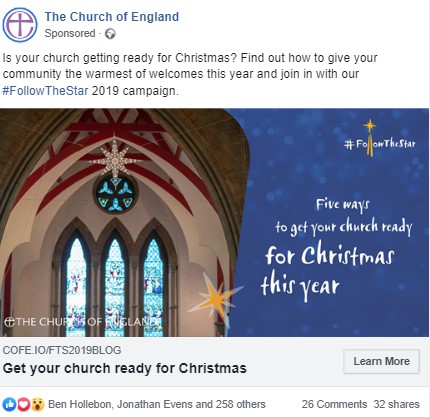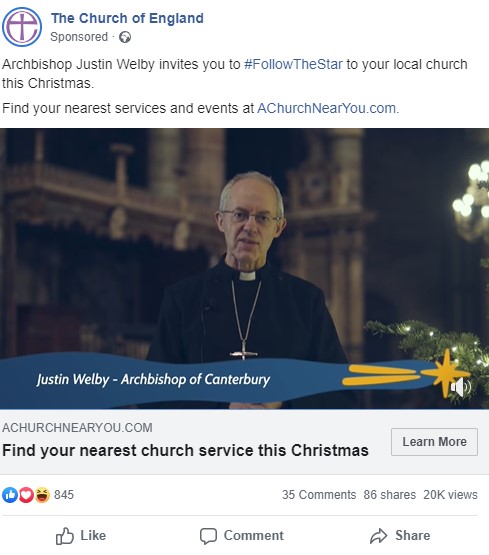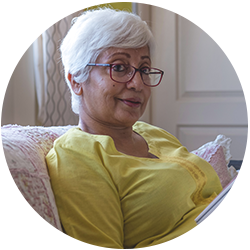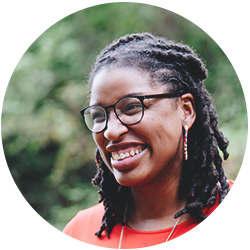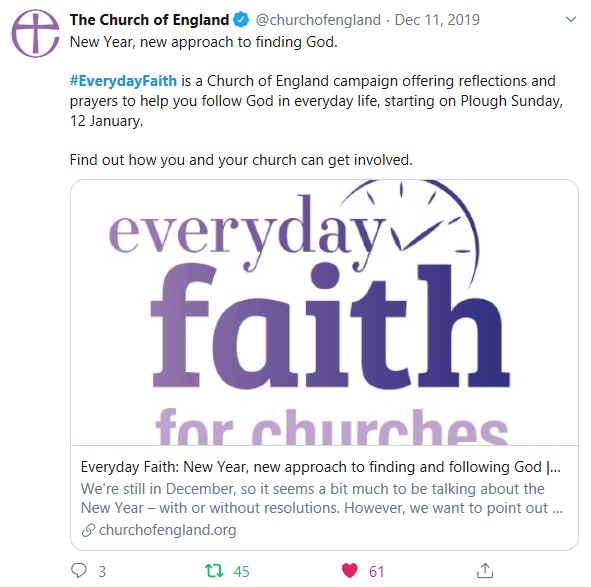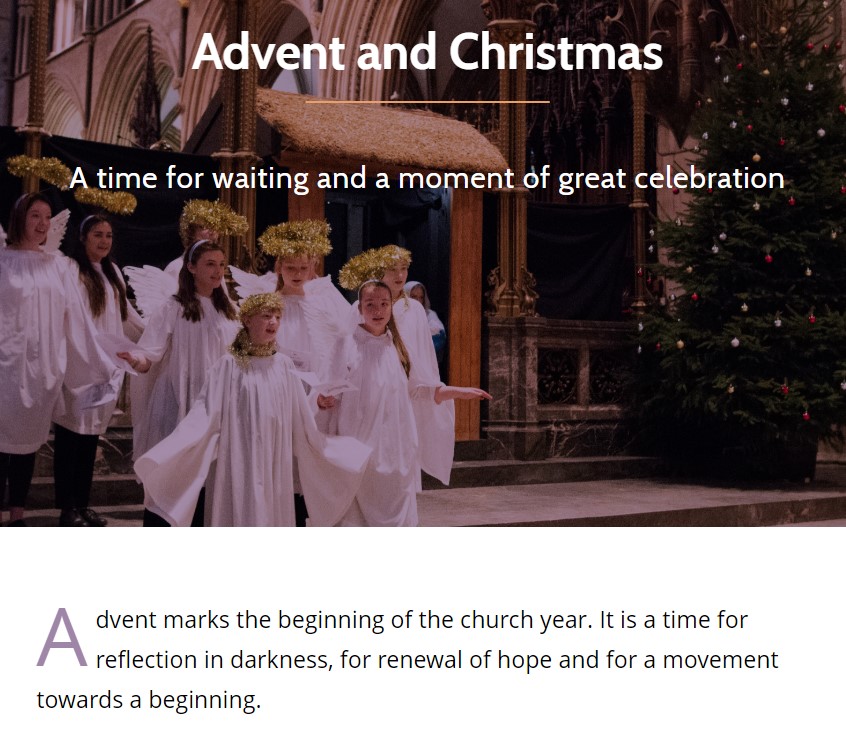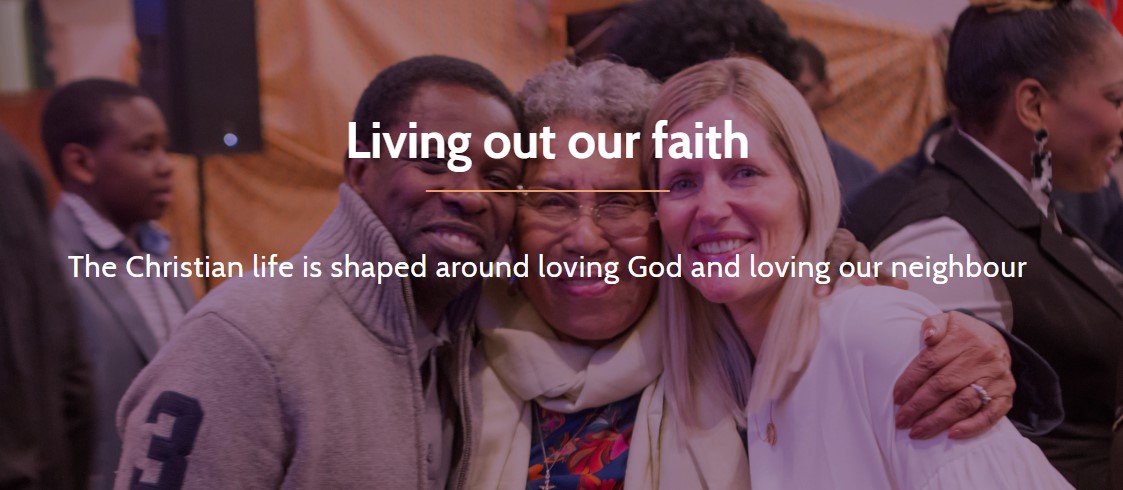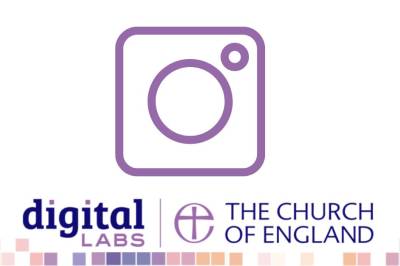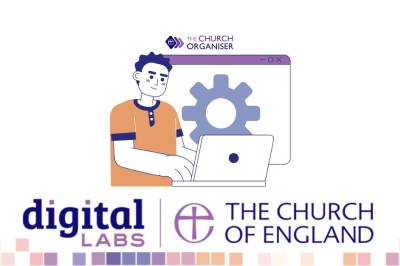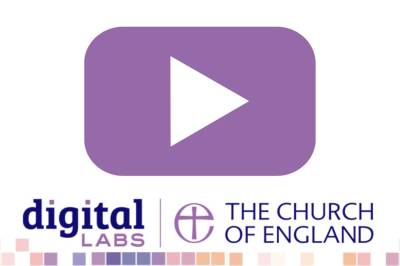17/02/2020

This may not necessarily involve spending money on advertising and, if it does, won’t require large sums. We have had lots of success nationally with small £10-£50 budgets.
As a national Church, we aim to reach all people in all places. The focus on specific audiences can be helpful when thinking about how to invite people to a Christmas service, to encourage participation in a Lent group or to encourage people to attend an event. The reason for this is that the content and language used may be different. Those who are familiar with church are comfortable with words that occasional churchgoers and those less directly involved won’t be.
Here are two examples of social media posts and adverts from #FollowTheStar 2019:
Clergy and church leaders
People open to the Christian faith
The first screenshot above uses a question to engage clergy and leaders to get involved with #FollowTheStar. The second is pitched at people open to the Christian faith to find services and events and uses a video of Archbishop Justin and language such as “invite” as we know from our research that people respond warmly to this.
You can read more about the reach and engagement with #FollowTheStar over Advent and Christmas 2019 in this recently published blog. The number of people who described #FollowTheStar as helpful, very helpful or extremely helpful in bringing them closer to God grew from 85 per cent in 2018 to 94 per cent in 2019. The number of times the campaign was seen on social media grew to 12.6 million in 2019 from 7.94 million in 2018.
The aim of this article is to look at:
- Why did we commission this research?
- How should audiences sit as part of your overall strategy as a church?
- Who are some of the audiences we are aiming to reach and engage?
- How do we apply this theory to our work?
- Helpful tips and next steps.
Now that this work has been developed over several years, we want to make it available for churches, leaders and dioceses to use.
Why did we commission this work?
In January 2017 we worked with an external agency to complete a three-month research project, where we spoke to 1,800 people across the country including clergy, regular and occasional churchgoers and those open to the Christian faith. This included doing the following to understand what people found frustrating, what they’d like to see more or less of and, crucially, how Christians grow in faith and how we bring new people to faith:
- Focus groups in Carlisle, Blackburn, Birmingham and London
- 1:1 interviews
- Targeted national online surveys through social media
- Website analytics.
This work was commissioned when the Church’s national Digital Team had just been created and the outputs became the basis for everything we now do. Without this, we would have had to rely on guesswork. Using the research, we developed a series of audience personas to help us to crystallise in our minds how we could reach and engage people including regular churchgoers, people exploring faith, new parents and occasional churchgoers.
The key finding was that there was a huge of amount of interest and excitement about going further in faith journeys but that the national Church was not making it easy through its various digital offerings, particularly our website and social media presence. As a result of the work we were able to commence work on the Church of England, Archbishops’ and A Church Near You websites, all of which were launched by early 2018.
The following bullets show just some of the key changes we made to one of our websites, www.churchofengland.org, to enable millions to go further in their faith journeys:
- Simple navigation, a good search engine, improved website accessibility, mobile-first and clean design!
- A transformed Our faith section that explains Christianity in an engaging way.
- New Faith in action films that bring to life the missional work of the Church.
- A streamlined Prayer and worship section, including liturgical and prayer resources, thanks to the work of Church House Publishing.
- A new life events section better explaining baptisms, confirmations, weddings and funerals as well as vocations.
Over the summer of 2018, we commissioned further research with a range of socio-economic groups in different regions of the country through focus groups and surveys to measure whether the changes we made to our websites had been effective. In addition, the review covered our 2017 #GodWithUs Christmas campaign. We were encouraged by the findings on the Church of England website and I have copied the section from the report below:
- On balance, participants were impressed by the website.
- Many felt that the look and feel is far more modern than they would have expected from the Church
- It is user-friendly and easy to navigate
- The content is well-presented and easy to digest. For example, the text is effectively broken up by videos, images and quotes.
- "It's a good mixture of simple text - it's not big, long paragraphs - and pictures and videos. It was better than I was expecting." University student, Newcastle
- "I didn't think they would have a website and when they did I was expecting it to look like a website from the 90s, but it actually looked quite modern." Open to faith, Ely
However, there were also some concerns:
- Most notably, participants felt that the website is aimed at people who are already familiar with the Church: it assumed a level of knowledge about Christianity that not everyone has.
- It was also felt to be difficult to find information about community events and activities. Given that, for many who tested this website, these events are their main reason for engaging, there was an expectation that they would be more prominently advertised.
As a result of the above comments, we tweaked the website to make A Church Near You more prominent and help point people to local services and events. We also encouraged more people to sign up as A Church Near You editors through in-person events in churches and social media advertising, leading to uplift from 10,000 to more than 17,000 in just two years. This has helped ensure there are more active church pages on the website.
In the first year of the new Church of England website going live the website received nearly two million new visitors, and aside from the 18-24, which was slightly lower, the age ranges engaging with the website were broadly equal.
How should audiences sit as part of your overall strategy as a church?
I wrote a blog last year setting out how churches could develop an effective digital strategy that aligns with the overall mission action plan of the church, usually developed by the vicar, churchwardens and PCC. Audiences was the second area I recommended churches think about as part of the overall approach.
Who are some of the audiences we are aiming to reach and engage?
We have developed personas for eight audience groups (they are listed in no specific order below). The personas aim to bring to life how a group of people can be motivated to go further on their Christian journey and what drives them. They are broad examples and obviously not everyone thinks in the same way as outlined below.
I have also written an example of a digital journey that each persona could take. These are based on insights we have gathered over the last three years on how different groups behave on the web and social media. A lot of the examples show why it is important to have an active email account and a presence on AChurchNearYou.com. Read more about how you can start editing your page.
Regular churchgoer – Martin
Martin is married and has three children, a girl aged 10 and two boys, aged 14 and 16. He attends church regularly with his wife and their three children.
Faith is a big part of his life - he studies and reads books on Christianity, the family socialise with other families from the congregation, and he has been on holiday with his local church. Martin and his wife do voluntary community work with a local Christian project that provides hot meals for homeless people in the local area. They want to give something back to society and live out their Christian values.
A potential digital user journey may look like:
- Martin wants to promote the new foodbank his church is starting
- He becomes an editor on AChurchNearYou.com as he knows his church’s page gets thousands of visitors a year
- The vicar, as overall administrator, approves his access
- Martin adds a new page on the work of the foodbank to enable local people to donate and enable those in need to get involved. He also adds this information to the events section of the site.
Occasional churchgoers – Sarah
This refers to someone who may attend a life event as a guest or go at Christmas and/or Easter.
Sarah lives in the small village of Hemsby in rural Norfolk. Her family are from Great Yarmouth, and her parents still live there. She and her husband both commute into work in Norwich. She was brought up by parents who attended church, she got married in a CofE Church in her mid-20s.
Sarah has two children, both girls, aged 9 and 12. The children were both christened. However, she now only goes to church at Christmas. She views the CofE as being as an important part of English society. She does occasionally pray at times of stress or when faced with very difficult situations and identifies as a Christian/Church of England when asked.
At Christmas, a digital journey for Sarah may look like this:
- Sarah searches for her local church on Facebook to see if they have added services and events and sees that they have a page
- She notices the link to AChurchNearYou.com listing their Christmas services and events
- Sarah clicks through and sees that there is a carol service she can go to with her family. Sarah adds the details to her calendar and attends the service.
Lay leaders – Hilary
Hilary has always been a committed Christian, and since she retired has been playing an increasing part in the running of the local church. The church community is an important part of her life - most of her friends are also part of the congregation. Being more involved in running the church has strengthened these bonds.
A potential digital journey for Hilary may involve her exploring Lent resources that the congregation can use as part of the weekly study groups:
- Hilary visits the Church of England website and finds Lent resources
- Hilary publishes a link to the Lent resources on her church website and encourages people to join study groups for Lent
- Hilary prints the Lent posters out to advertise in her church.
New parents – Gavin
Gavin’s life recently became dramatically different when his wife gave birth to their first child. The child, a girl they’ve called Fran, was born a few weeks ago. He feels it is important for his daughter to be baptised so that she can make her own mind up in the future.
Gavin believes it is important to give their child ‘a good start in life’ and to do the right thing for her. He wants to appoint Godparents who will be there to support the child and advise them.
In terms of a potential digital journey, Gavin:
- Searches for information about christenings as he wants to understand more about what’s involved and where the christening can take place
- He finds the Christenings section of the Church of England website and is redirected to AChurchNearYou.com
- Gavin makes contact with the priest of his parish church through the contact form to arrange a conversation.
Clergy – Peter
Peter has been a vicar for 20 years, having realised he had a calling to enter ministry a few years after leaving university. He had been working in smaller parishes for the last few years and has responsibility for six small churches.
He went into ministry not just because of his own personal faith, but out of a desire to spread the word and to help others.
What might a digital journey look like for Peter?
- Peter has been asked by several members of the congregation to record his sermon and make it available, which he does using a free app on his smartphone
- Peter sets up an account with Soundcloud so that the congregation can subscribe and listen on the go through iTunes and on other platforms
- The congregation download and listen to the content and use it as part of house groups.
Exploring faith – Reece
Reece is exploring faith to help him after a series of challenging life situations. He is 18 and about to attend college and has many questions about Christianity. As a starting point, Reece is keen to explore more in his own home and in his own time.
How might Reece use the Church’s Alexa skill through the free app on his phone?
- Reece searches the Alexa store for ‘Christianity’ and notices the Church of England has a skill
- He opens the skill and asks a series of introductory questions about faith
- As it is Christmas, Reece starts exploring the daily Christmas reflections audio content.
Non-Christians – Sharon
Sharon is researching her family history and visited her local church cemetery to find the grave.
What might the church do?
- Sharon contacts the church to ask if her grandparents are buried there
- She uses the website contact form, which has a tickbox opt-in for further contact and to be added to the mailing list. Sharon selects this
- The church replies and helps identify the location of the grave
- When it comes to an All Souls service, the church has a list of contacts. They invite her to the service and Sharon attends with her mum and dad.
How do we apply this theory to our work?
In the introduction, I showed you an example of social media posts that were created for different audiences. Here are a few more examples of recent posts, the first aimed at people exploring faith and the second at regular churchgoers and church leaders.
People exploring faith
Regular churchgoers and church leaders
In addition, the top menu of the Church of England website is a good example, where the first three sections are designed to help those exploring faith and occasional churchgoers to go further on their journey.
Here are a few more examples of how we are engaging with people who are occasional churchgoers or open to faith.
Helpful tips and next steps
- The personas above don’t just apply digitally and they can be used for a whole range of activities across your church
- The persona groups (regulars, open to faith, new parents etc) can be tweaked by your church to help with your individual priorities. This would make for a good PCC discussion
- Keep it simple and focus on doing a couple of things well rather than lots badly. With Lent and Easter on the horizon, there are several key audiences that can be engaged with:
- Lent – encourage attendance at Lent study groups for regular attendees
- Easter – open to faith and occasional churchgoers can be invited to Easter Day services. In addition, how might regular churchgoers help with inviting people in their networks, both offline and online?
- You will notice how important imagery is in the examples shared in this blog. We have built a free image library into the AChurchNearYou.com Resource Hub, which all CofE churches can use. Find out more on the help centre.
- We also have a range of Faith in Action and Our Faith videos available on our YouTube page for reuse.
- Make sure you claim your AChurchNearYou.com page.
- Sign up for our Labs Latest newsletter to receive monthly emails featuring hints and tips on how you can make the most of the web and social media.
Conclusion
The aim of the personas highlighted above is to show the value of the web and social media as places for people to find and engage with their local churches and Christian resources. Not all journeys are going to be perfect and linear and they are merely examples to help you think about how you can make the most of the free resources that are available. As mentioned in the introduction, the Church of England is a national Church and committed to serving all, so please don’t think that we focus on the groups above and no one else. This is not the case!
We recognise that there are clearly other groups we want to reach and engage with as we start to implement the approved digital strategy for 2020-22, including university and college students and working with schools and youth leaders. We have just completed a research exercise with the latter two groups and plan to share more on this in the months ahead as part of the Growing Faith digital work with the National Education Office.
As the blog I wrote last year on digital strategy kept emphasising, this work should not sit in isolation and even if you decide to only focus on a few areas you should encourage buy-in from across the church, including the PCC.
I hope this blog has been useful in helping you to think more about how you might engage with audiences and the content you may develop. Do let me know if you have any comments or questions here.
Adrian Harris
Head of Digital, The Church of England
